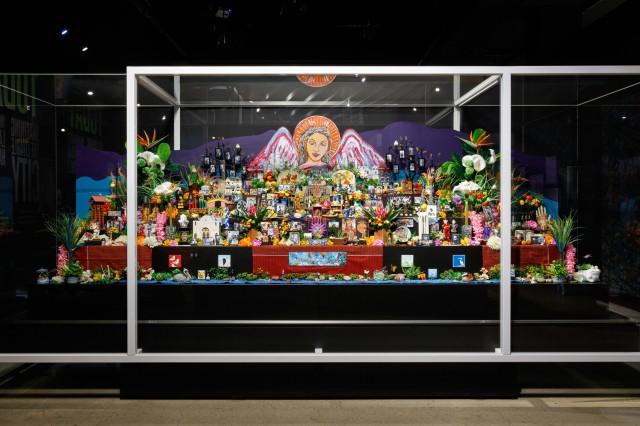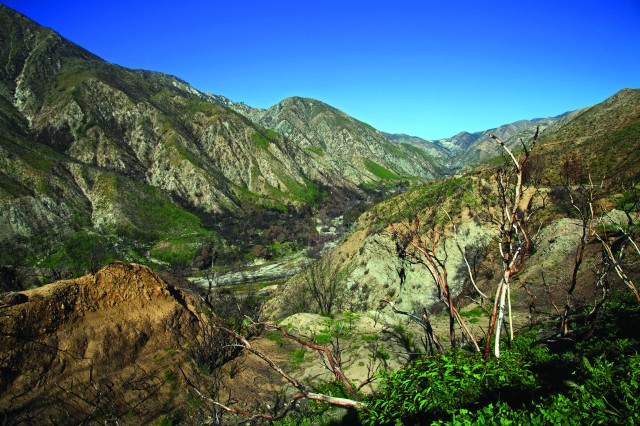Match Point
Regan Dunn, Interim Assistant Deputy Director and Assistant Curator at La Brea Tar Pits, looks at the pervasive planetary issue of fire with a long-term lens.
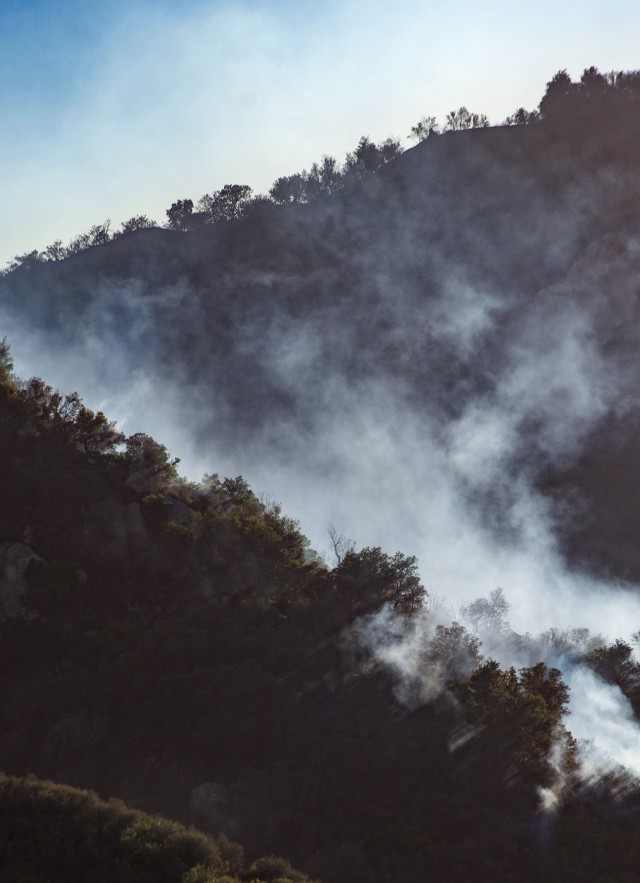
Published September 16, 2023
Regan Dunn, who is also a paleobotanist, talks with the Naturalist about how fire has shaped and fueled the biodiversity on Earth for millions of years, and how people have contributed to this ignition—then accelerated the burning—and what we can collectively do to dampen the flames.
What are the oldest records that can offer a window into the history of fire?
The Quaternary history of fire in Southern California isn't very well known. But, there are a few records. I would say that the best fire histories we know of are from the Holocene (the last 12,000 years, or so). The “fire records” I am referring to come from the presence and abundance of charcoal found in sedimentary archives like lake cores or in soil profiles.
It is a bit surprising that we don’t have a better handle on the prehistory of fire in our area, but that just means there is a lot of work that needs to done—an exciting prospect for a paleocologist! The records that we do have, such as one from Baldwin Lake in the San Bernadino Mountains, suggests that fire was relatively rare in sub-alpine ecosystems west of the Sierras during the last glacial, or ice-age period that spanned from 120–15 thousand years ago. This time period, which was certainly cooler, wetter, and less productive vegetatively than during interglacial periods, like the Holocene. For coastal southern California, we only have a few records. The best is probably from Santa Rosa Island, one of the Northern Channel Islands. The charcoal record there suggests that fire became more prevalent around 14 thousand years ago, and really spiked at 13 thousand years ago when humans arrived to the islands. Fire became much more prevalent in our ecosystems after this point in time. This is likely because of human use of fire, but also the warmer and drier climatic regime of the Holocene.
The uptick in fire with the arrival of humans makes a lot of sense, because fire has been one of the most important tools that has enabled our existence and spread across the globe. In fact, the first evidence of our ancestors using fire comes from early hominids like Homo erectus as long as 1.4 million years ago. Often times, the first sign of human arrival to a new location is the presence of charcoal. This is certainly the case of several of the Pacific Islands, and along with the charcoal, comes a transformation of the ecosystems. This process has taken place nearly everywhere on Earth. The process continues every day—we burn fires every second, it's just that we're burning fossil fuels in boxes. Everything involves ignition of something as an energy source.
Why is the frequency and intensity of fires increasing?
We're dealing with a lot of different factors. First, there is the increase in carbon dioxide [from burning fossil fuels], which has been massive. The increase in CO2, or plant food, has increased plant biomass. Now, there is a lot of research showing that the increase in the number of fires and the area of land burned is caused by warming. If you turn up the thermostat, soils become drier and plants become more stressed. This is the result of climate change and that's going to get worse. In addition, fire suppression in forests over the last century has added to the problem by enhancing biomass available to burn. And, of course, the expansion of human development into the wildland interface has added to the fire suppression efforts as nobody wants their property and or valuable timber resources to burn.
To thrive, many plants, animals, and ecosystems depend on particular patterns of fire, right?
Yes, every ecosystem is going to be different and I think that's really important to know. Different systems have different fire tolerances, requirements, and management needs. You can't treat the shrublands like you treat a forest. You can't manage a pine forest like you manage the chaparral [coastal biome with hot, dry summers and mild, rainy winters]. For centuries, the Coastal Mediterranean ecosystems here and all over the world had fire intervals of every 40-60 years. Now, when you have fires occurring too frequently, every couple of years, the plants, especially native plants, in those systems don't have an opportunity to re-sprout, re-colonize, or re-grow. So, you don't get the natural successional process of vegetation. Instead, what you get is a bunch of fire-prone exotic grass, invasive tumble mustard that can burn again and again. It grows quickly, gains a lot of biomass in the spring rains, produces a lot of seed, and then burns again. What you get back, is this grass again—biomass for the next fire. In the process, the biodiversity of the native chaparral both in terms of the plants and the animals it supports declines dramatically. For these chaparral ecosystems, what it comes down to is that we need to prevent fire there in order to preserve them.
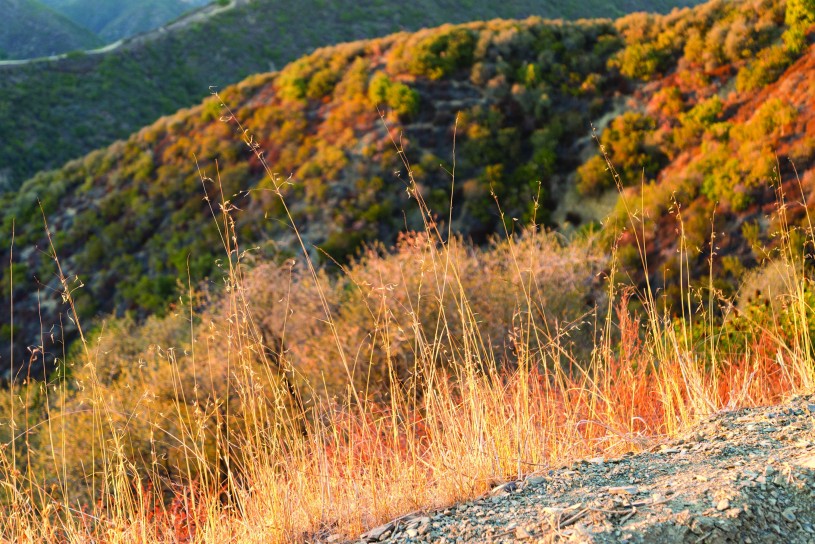
How should the “fire regime” be different in forested areas, and can controlled burns help defend against big blazes?
In the forest, prescribed fires can clear out the understory and reduce the amount of fuel, or plant biomass, in the forest. This process can prevent the most severe and intense fires during big fire seasons. For instance, ponderosa pines have many adaptations to resist low temperature fires on the ground. One of the problems with fire suppression in these forests is that seedlings and saplings of intermediate heights have created ladder fuels which allow fire to reach the canopy. Fires like this are much hotter and intense and can be much more catastrophic to forest ecosystems. So prescribed fire can aid to prevent these most dangerous and damaging of fires.
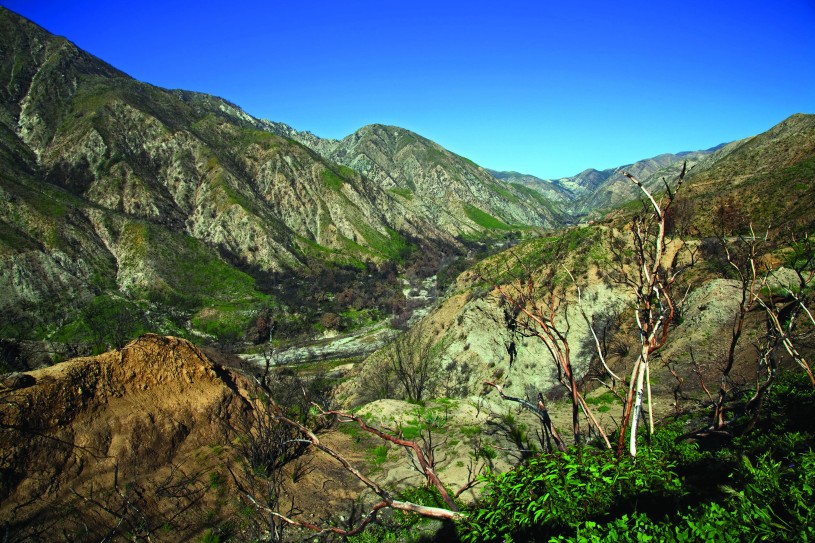
Green native chaparral reviving after a fire in the Angeles National Forest in Southern California six months after the Station Fire.
What are the most common ways fires start in Southern California?
Most of the widespread fires that happen, of course, are anthropogenic [human caused] and power lines are a huge source of fires in our area. Other causes include fireworks, automobiles, firearms, escaped campfires, cigarettes, and unfortunately, arson. While Southern California is so well known for our dramatic fires, it is less well known that almost all of these fires in coastal areas are caused by humans. Less than 5 percent of these fires are caused by lightning. In fact, coastal California has some of the fewest lightning strikes than anywhere in the country. Of course, there is much more lightning in the Sierras and other locations in the state. But, here fire is mostly human caused!
How do wildfires impact biodiversity?
Wildfire impacts biodiversity by changing the vegetation. After big burns, there can be a lack of food resources, and also habitat, as the landscapes are much more open. In these open landscapes, animals are more easily preyed upon on because of a lack of protective cover. Big fires also change the hydrology of a system, whereby soils can become much drier and are more easily eroded. During high intensity fires, microbial and fungal communities in the soils can be altered or lost, and those take a long time to recover. While fire is a natural process, and a restorative one, the increase in fires caused by humans across the globe are adversely impacting ecosystems. This is especially true in ecosystems where fire is rare and plants and animals lack adaptations to recover from them.
What are some things we can do, individually and collectively, to reduce wildfires?
We can reduce greenhouse gas emissions to keep the climate stable. A stable climate is our friend, and keeping temperature from rising in the future is key to maintaining ecosystems as we know them. One of the most immediate things we can do in California to prevent catastrophic wildfires is the burial of power lines, and we need the funding to do that. This would be huge! Additionally, we can support prescribed burning in forest ecosystems and prevent frequent fires in the chaparral habitats. Herbivores can be used to reduce fuels and green fire breaks could be created. Importantly, we could fund and implement aggressive restoration of chaparral ecosystems following fire with the planting of native plants. We know these things will help us protect biodiversity in these California Mediterranean ecosystems. We just need to do it!
